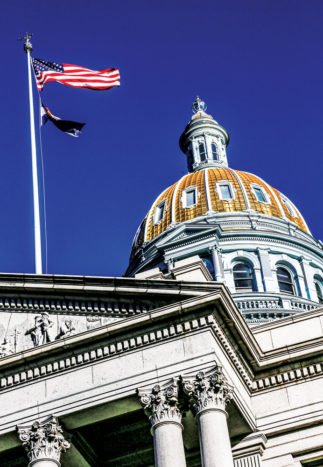
Colorado State Capitol Building. Front Porch file photo by Steve Larson
Colorado lawmakers will have billions of extra dollars to spend during the 2022 legislative session—and after that most of it will be gone.
A bonanza of money, both state surpluses and federal pandemic relief funds, is giving lawmakers the chance to address some important needs and to save for the future. But they’re going to have to be careful about creating new programs with permanent staff, because the state surplus is one-time, and the federal funds have to be spent within a few years.
Beyond money, a rising crime rate, increasing numbers of drug abuse deaths, and reproductive rights are likely to be on the legislative agenda, at least rhetorically if not substantively. Resumption of statewide student achievement testing and possible modernization of the K-12 school funding formula also may be considered during the session.
And there are two substantive, if somewhat bureaucratic, issues that lawmakers must decide. Both involve establishment of two big new state agencies, a Department of Early Childhood and a Behavioral Health Administration. Both agencies are intended to create efficiencies by combining offices and programs now scattered among various state departments. Both were created by laws passed in 2021, but it’s up to the 2022 session to fill in the bureaucratic, procedural, and funding details needed to stand up the two agencies.
It’s all about the money
Lawmakers have two big pots of money to deal with.
State revenues—Those have been growing at higher-than-forecast rates since before the pandemic first hit, leaving the state with a “surplus” of about $3 billion. That’s considered to be one-time money because revenue growth is expected to return to lower levels of 3-4 percent annually in coming years.

Senator James Coleman, Senate District 33
In fact, state revenues have been so good that taxpayers are projected to receive about $6 billion in refunds through 2025 under the provisions of the constitutional Taxpayer’s Bill of Rights, which require refunds if revenues rise above certain annual limits. You won’t get a check—refunds are paid through indirect methods like temporary sales tax reductions.
Gov. Jared Polis has proposed a big package of proposed spending focused on four priorities—fiscal responsibility, relief for individuals and businesses, public safety, and improving air quality.
Those include a 15 percent state reserve, temporary reductions in fees for things like professional licenses and business registrations, expansion of the Colorado Bureau of Investigation, two new campuses for the homeless, grants for purchases of electric school buses, and expansion of the Air Pollution Control Division.
Polis also wants to “prepay” some known future expenses, like part of school funding and the state’s contribution to the Public Employees’ Retirement Association (PERA). The idea is that setting aside money for such things now will reduce pressure on routine state spending when annual revenues return to normal levels.
The governor’s budget plan totals $40 billion from all funds, including federal and fee revenues, and about $17 billion in the state tax revenues called the General Fund.
Legislative economists estimate that if Polis’ budget plan were to be adopted in full, there would be only $183 million left over for other spending. So there will be plenty of push and pull between the governor and the legislature before a final 2022-23 budget is adopted sometime next April.

Rep. Leslie Herod, House District 8
One important budget issue lawmakers will have to think about is state employee pay. The state’s new collective bargaining agreement with state workers includes a three percent raise. But state agencies are struggling with high vacancy rates and small applicant pools, part of the “great resignation” trend that affects the entire economy. There are significant vacancy rates among health and safety staff, as well has among state contractors like community mental health centers.
Revenue from the American Rescue Plan Act (ARPA)—Lawmakers will have to deal with about $1.6 billion that Colorado received from the massive federal ARPA pandemic relief bill passed by Congress in 2021.
The 2021 legislative session reserved that money for spending on three areas in 2022— behavioral health, affordable housing, and general economic relief and recovery.
Three large task forces of legislators and state agency directors, each with advisory panels of experts, worked over the summer and autumn developing recommendations for spending those funds.

Rep. Steven Woodrow, House District 6
But those task forces were given until early January to file their reports, so those were still being finalized over the holidays. And the task forces did not have the authority to introduce bills during the 2022 session. So, the bills needed to spend the money likely won’t take shape until legislative leaders and the governor agree on how to spend the money.
Much of the affordable housing money is expected to end up in state loan and grant programs that provide funding to local governments, non-profit agencies, and developers.
There’s expected to be significant debate over how much of the relief and recovery money should be used to support the state’s unemployment insurance fund, which has been tapped heavily during the pandemic and now is supported by loans from the federal government. Such loans typically are paid back by higher fees on employers. Some lawmakers, particularly Republicans, would like to reduce that burden by using relief money to support the insurance fund.
The federal ARPA money is not part of the main budget and has to be spent within four years.
Beyond the money
Legislative policy proposals don’t really start coming into focus until the first big waves of bills are introduced during the opening days of the session. (This year the session convenes Jan. 12.) And the governor’s priorities get fleshed out in the state-of-the-state speech on the second day of session.

Rep. Jennifer Bacon, House District 7
Behavioral health, which is larger than just creation of the new agency and spending the federal money, is expected to be a big issue this year. A recent series of media investigations have highlighted problems in the system, and the pandemic reversed progress that was being made on a backlog of evaluating criminal defendants with mental health problems. And rising numbers of substance abuse deaths started to attract official attention late in 2021.
Crime may well be an issue during the session as minority Republicans already have been trying to tie those trends to Democratic criminal justice reforms passed in recent sessions.
Other issues that already have started to surface are unionization rights for local government employees, the level of state support for PERA, controls on water speculation, simplification of the sales tax system, and state support for wildfire prevention and recovery efforts.
During the 2021 session, majority Democrats were able to push through significant packages of bills on criminal justice, transportation, economic security, elections, the environment, and firearms control. Whether they will be as ambitious in 2022 —an election year—remains to be seen.
Another pandemic session?
Legislature sessions normally are limited to 120 consecutive days a year. During the pandemic sessions of 2020 and 2021, the legislature was able to adjust its schedule because the state was under a Polis health emergency declaration. That declaration is no longer in effect, and the impact of the Omicron variant in Colorado remains to be seen, so only time will tell if 2022 will be the third pandemic session.
A last hurrah for this group of lawmakers
Colorado legislative boundaries were redrawn in 2021 by an independent commission to reflect population changes recorded by the 2020 census.
“Redistricting,” as it’s called, had the usual uncomfortable consequences for some lawmakers, like changing the partisan makeup of some districts and putting two incumbents in the same district in a few instances.
Despite the new boundaries, Democrats are predicted to have the better odds of controlling both chambers.
But term limits and legislator ambitions for higher office also will have an impact on how many 2022 lawmakers will be around when the following session convenes in January 2023.
In addition to incumbents who may be turned out in the November 2022 elections because of redistricting changes, about a quarter of the body’s 100 members are running for other offices, are term limited, or are leaving for other reasons. (Several members of the House are running for the Senate.)
And four of the House and Senate’s six party leadership positions will turn over because of term limits. That includes House Speaker Alex Garnett of Denver and Senate President Leroy Garcia of Pueblo, both Democrats.
Todd Engdahl is owner of Capitol Editorial Services, a firm that provides legislative coverage, intelligence and analysis to private clients. During a long career as an editor and public policy writer, he served as executive city editor of The Denver Post, founder of DenverPost.com and co-founder of Education News Colorado, which later became part of Chalkbeat Colorado.


0 Comments